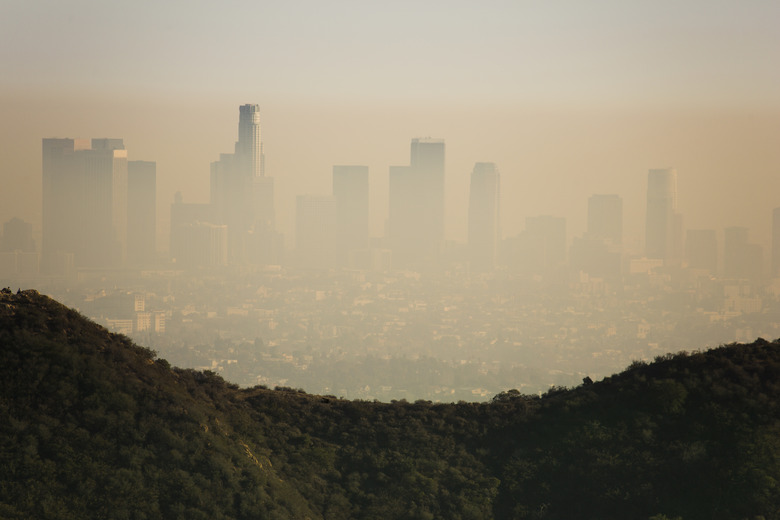The Difference Between Smog & Fog
When you look up at the sky, you may notice low grayish clouds in the sky. Is it smog or fog? Though they look the same, smog and fog are formed quite differently. Smog is a form of air pollution, resulting from chemical toxins dispersed into the atmosphere whereas fog is the accumulation of floating water droplets in the air.
Fog
Fog
Fogs are composed of water droplets, which disperse light and reduce visibility near the earth's surface. Fog layers form when moist air is cooled to its dew point (or saturation point). There are several different types of fog, which are formed under varying circumstances.
- Radiation fog typically forms at night when surface heat is radiated into space. As the earth's surface cools, the air reaches complete humidity, which then turns into fog.
- Advection fog closely resembles radiation fog, but is formed when warm moist air moves horizontally over a cold surface, causing condensation. One common type of advection fog is sea fog, which occurs when air from warm currents drifts over cold currents.
- Unslope fog forms in higher elevations, such as mountains or hills. Winds push moist air up a slope to a point where the air begins to condensate, forming fog. Unslope fog can be very expansive, often covering entire mountain ranges.
- Ice fog is formed from ice crystals. As the name suggests, ice fog forms when the air temperature is below freezing.
- Freezing fog is composed of "supercooled" water droplets, which change from liquid to ice upon surface contact. Objects exposed to freezing fog are often covered in an ice layer.
Evaporation or mixing fogs occur when water vapor (from evaporation) mixes with cooler, drier air. Steam fog forms when cooler air drifts over warm water, whereas frontal fog forms when warm rain droplets evaporate into cooler air near the surface.
Effects of Fog
Effects of Fog
Fog is generally associated with hazardous driving conditions. Because drivers cannot see very far in front of them (oftentimes, their depth perception becomes skewed), foggy weather can cause many dangerous accidents.
When driving in low visibility, keep your speed under 40 mph and use just the low beams on your headlights. Do not use high beams, as they can reflect fog back onto your windshield.
Smog
Smog
In the early 20th century, smog originated as a blend of smoke and fog. In 2011, it is defined as mix of ground-level ozone and other pollutants. Ground-level ozone, unlike the earth's elevated ozone layer, can cause choking, coughing and other health problems.
Smog forms when organic compounds and nitrogen oxides chemically react with sunlight to create ozone. These pollutant compounds often come from automotive exhaust, factories, power plants and even your hairspray.
Effects of Smog
Effects of Smog
Smog is linked with automobile traffic, sunlight and mild winds. Extremely warm and sunny days expedite smog formation; the longer the warm air remains stagnant near the surface, the longer the smog is bound to stay.
Most major cities experience smog, especially in areas of heavy automobile traffic, such as Los Angeles. In addition to harming the environment, smog causes breathing ailments, asthma, lung infections and eye irritations. Smog also damages plants and forests.
To find out how much smog is in your city, check out the Air Quality Index, also called the Pollution Standards Index.
Cite This Article
MLA
Kim, Jen. "The Difference Between Smog & Fog" sciencing.com, https://www.sciencing.com/difference-between-smog-fog-8093163/. 19 April 2018.
APA
Kim, Jen. (2018, April 19). The Difference Between Smog & Fog. sciencing.com. Retrieved from https://www.sciencing.com/difference-between-smog-fog-8093163/
Chicago
Kim, Jen. The Difference Between Smog & Fog last modified March 24, 2022. https://www.sciencing.com/difference-between-smog-fog-8093163/
